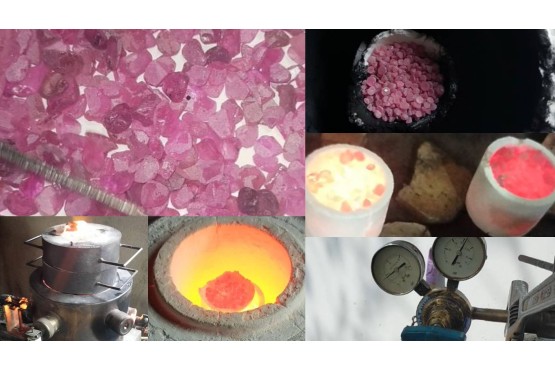The Jewelry You Own Was Cooked in a Backstreet Oven
-
The Jewelry You Own Was Cooked in a Backstreet Oven
July 23, 2025
LuxuryInvesting | FamilyOffice | HighNetWorth | AlternativeAssets | HandMade | AssetIntegrity | InvestmentStrategyMost family offices pursuing luxury investing think getting closer to the gemstone source means better alternative assets. Three years building relationships from Sri Lankan mines to Madagascar dealers taught me the opposite: synthetics and treatments enter precisely where high net worth investors seek handmade authenticity, compromising asset integrity.
The first time you walk down Gem Street in Ratnapura, you’re just another buyer.
They nod. They smile. But they don’t take you seriously.
Until you start asking the wrong questions. The kind that reveal you might know too much.
Until you say things no outsider says.I didn’t show up with swagger.
I showed up with knowledge.
Four times in three years. No shortcuts. No "friend of a friend."Eventually, they stopped seeing me as a customer… and started nodding like brothers.
One day, a major dealer, no paperwork, no hesitation, handed me an 11-carat unheated blue sapphire worth $30,000 and said:
Take it to the gem lab. I know you’ll come back.The Trust That Opened the Furnace
That trust led me deeper.
There’s a man. Everyone in Gem Street knows him. But no one tells you where he works.
Because he doesn’t work in town.His furnaces are hidden. Deep in the forest. Beyond the last bend. Far from any accidental visitor.
No signs. No address. You’re either invited or you’re not.He’s spent 20 years mastering heat. Not random torch work. Scientific flame geometry. Precise timing per parcel.
When the nod came:
Go there, ask for him by name.
I went.No Greetings. No Small Talk. Just Heat
The process took two days.
The temperature? 2200 degrees Celsius.A custom gas–helium–oxygen blend. The only way to push a flame that hot without destroying the gem entirely.
I quietly turned on my camera.
He silently left the room.He said:
Your face won’t be in it.
You’re here alone.What Happens in the Fire
Cloudy, low-value stones go in.
Shiny, saleable stones come out.Big brands buy them in bulk.
Set them in platinum. Tuck a piece of silver foil beneath the gem to help it shine.No one ever sees the foil.
No one ever suspects the burn.They’ll tell you it’s heat treated.
But not what that means.Not that the rutile silk, the stone’s ancient fingerprint, has been melted to death.
Not that zoning has been erased.
Not that the crystal structure took a thousand years to form… and five hours to forget.
What Heat Destroys, Time Once Built
It’s like bathing in a wild hot spring. The water flows from deep within the earth, full of mineral vitality.
People travel miles for its healing balance. But boil that same water at home, and much of its benefit disappears.
What made it alive is gone.
Sapphires are the same. Their inner life, their subtle resonance, is born in pressure and time.
Once reheated unnaturally, it’s not just color that changes. It’s character.The Same Game in Madagascar
I saw the same pattern far from Sri Lanka. In Antsirabe, Madagascar.
There’s a quiet corner of town where miners gather to sell their finds.
I bought rough ruby there. Sat with them. Spoke eye-to-eye.Anything I declined, I watched disappear across the street.
Eventually I asked:
Who are they selling to over there?A woman replied plainly:
That’s the final stop. Nigerians buy everything, by the kilo. Low prices. No questions.They ship it to Chantaburi for bulk heat treatment.
After that, the stones pass through Silom Road in Bangkok.
Polished. Reclassified. Sold to overseas buyers under lights and glass.The chain is global.
The illusion is uniform.The Industry’s Chemical Toolbox
Even some Sri Lankan traders send rough or heavily included stones to Chantaburi.
There, decades of expertise have built a refined arsenal of treatments:* Beryllium diffusion
* Glass-filling
* Chemical enhancements
* And moreThese methods can dramatically transform stones, often beyond what simple heat treatment achieves.
It’s an industry reality.
Widely understood among insiders.
Seldom fully disclosed to end buyers.Once stones reach the polished markets around Silom Road, they often carry a story crafted as much by chemistry as by nature.
That’s why I personally avoid purchasing gems directly in Thailand.
My focus remains on raw, traceable stones sourced with integrity.
Stones that tell their true story.But the story didn’t stop in that furnace room.
Outside, in the open, I was fighting a quieter battle.
Gem dealers mocked my cutting style at first.
They thought I was crazy to abandon standard weight-saving cuts.They asked:
Why throw away value?Because I saw what they couldn’t yet see:
True sparkle comes from geometry, not carats.I sat for days with one of the region’s top cutters.
We wasted cheap parcels dialing in angles. Light paths. Crown depths.We pushed until he saw it. And when he did, we switched to the real stones.
When those first cuts were finished, I handed them to the same dealers who’d laughed.
They held them up to the light… and stopped talking.Weeks later, I heard:
You can mention his name. Ask for the special cut. We know.That’s how real trust is earned.
Not with charm.
Not with money.
With conviction carried out over time.And that’s why I source raw. Unheated.
And why my stones are cut to ignite, not to survive a weight scale.So if you're holding jewelry that gleams too perfectly, ask yourself:
Was it born this way?
Or was it cooked… to please you?The Closer You Get to the Source, the Trickier It Becomes
Most think the trick is to get closer to the mine.
Buy direct. Cut out the middlemen.
They’ll say it like they’ve discovered a secret.What they don’t see is what I saw in Madagascar and Sri Lanka.
As you move closer to the source, the game changes.The parcels get heavier.
The prices get lighter.
And the synthetics slip in, quietly, beautifully, deliberately, because you think you're ahead.But on the street, I learned things they don’t teach:
* How to see a synthetic with the naked eye
* How to read a cloudy rough before it's even cleaned
* How to trace a gem’s behavior in the hand, not in a labSo no, I don’t chase mines.
I build relationships.And over time, I shaped four clear pathways for those who don’t want the illusion of access, but the reality of trust.
---
Field Access Inquiry →
https://www.gemwealth.store/curated-pathways-to-gemstone-acquisition-forms.html

